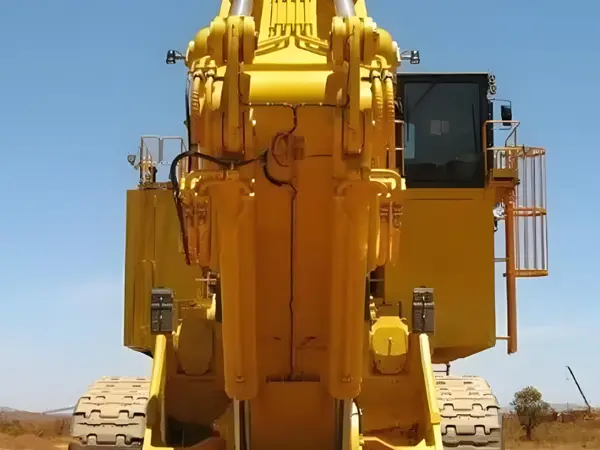Understanding the Science Behind Mini Excavator Hydraulic Cylinders: A Comprehensive Insight
Release time:
2025-04-06
Understanding the Science Behind Mini Excavator Hydraulic Cylinders Table of Contents 1. Introduction to Mini Excavator Hydraulic Cylinders 2. Overview of Hydraulic Systems in Mini Excavators 3. Key Components of Hydraulic Cylinders 4. How Hydraulic Cylinders Operate 5. Applications of Mini Excavator Hydraulic Cylinders 6. Common Issues and Maintenance Tips 7. Advancements in Hydraulic Cylinder T
Understanding the Science Behind Mini Excavator Hydraulic Cylinders
Table of Contents
- 1. Introduction to Mini Excavator Hydraulic Cylinders
- 2. Overview of Hydraulic Systems in Mini Excavators
- 3. Key Components of Hydraulic Cylinders
- 4. How Hydraulic Cylinders Operate
- 5. Applications of Mini Excavator Hydraulic Cylinders
- 6. Common Issues and Maintenance Tips
- 7. Advancements in Hydraulic Cylinder Technology
- 8. Conclusion
- 9. Frequently Asked Questions
1. Introduction to Mini Excavator Hydraulic Cylinders
Mini excavators are vital machines in the construction industry, integrating various components to perform complex tasks efficiently. Among these components, hydraulic cylinders are essential for facilitating movement and power in the machinery. Understanding how these cylinders operate and their significance in the overall hydraulic system is crucial for anyone involved in manufacturing, engineering, or construction.
2. Overview of Hydraulic Systems in Mini Excavators
Hydraulic systems utilize pressurized fluid to transmit power and enable movement. In mini excavators, hydraulic systems are the backbone, allowing for various functions such as lifting, digging, and rotating attachments. The hydraulic cylinder serves as the actuator within this system, converting hydraulic energy into mechanical energy.
2.1 Importance of Hydraulic Systems
Hydraulic systems offer several advantages:
- **Power-to-Weight Ratio**: They provide significant power while maintaining a compact size.
- **Precision Control**: Operators can perform tasks with remarkable precision and control.
- **Versatility**: Hydraulic systems can be adapted for different attachments and tasks.
3. Key Components of Hydraulic Cylinders
Understanding the components of hydraulic cylinders is essential for comprehending their functionality.
3.1 Cylinder Barrel
The cylinder barrel is the main body where hydraulic fluid is contained. It is designed to withstand high-pressure conditions.
3.2 Piston
The piston is a vital component that moves within the barrel. It generates force by exerting pressure on the hydraulic fluid.
3.3 End Caps
End caps seal the cylinder barrel, preventing fluid leakage and maintaining pressure within the system.
3.4 Rod
The rod extends from the cylinder, transmitting the force generated by the piston to perform work.
3.5 Seals and Gaskets
These components prevent fluid from leaking, ensuring the efficiency and effectiveness of the hydraulic system.
4. How Hydraulic Cylinders Operate
Hydraulic cylinders operate based on Pascal's law, which states that a change in pressure applied to an enclosed fluid is transmitted undiminished throughout the fluid.
4.1 Fluid Dynamics
When hydraulic fluid enters the cylinder, it exerts pressure on the piston, causing it to move. The direction of fluid flow determines whether the piston extends or retracts.
4.2 Control Valves
Control valves regulate the flow of hydraulic fluid, allowing operators to manage the movement of the hydraulic cylinder. By adjusting these valves, operators can control the speed and direction of the excavator's movements.
5. Applications of Mini Excavator Hydraulic Cylinders
Mini excavators are used in various applications, and hydraulic cylinders play a pivotal role in each.
5.1 Excavation and Digging
Hydraulic cylinders allow for powerful digging capabilities, enabling the mini excavator to break ground effectively and efficiently.
5.2 Lifting and Placement
The lifting function is crucial for moving heavy materials and equipment, making hydraulic cylinders indispensable for construction tasks.
5.3 Grading and Leveling
The precision control provided by hydraulic cylinders assists in grading and leveling surfaces, ensuring a smooth finish for construction projects.
5.4 Attachments and Versatility
Various attachments, such as buckets, breakers, and augers, can be powered by hydraulic cylinders, enhancing the versatility of mini excavators in different job sites.
6. Common Issues and Maintenance Tips
Understanding potential issues with hydraulic cylinders can prevent costly repairs and downtime.
6.1 Leakages
Fluid leaks are a common issue that can arise from damaged seals or gaskets, leading to reduced efficiency. Regular inspections and prompt repairs are essential.
6.2 Reduced Performance
If a hydraulic cylinder is not performing optimally, it may indicate low fluid levels or contamination. Keeping fluid levels topped up and using clean hydraulic fluid can mitigate these issues.
6.3 Cylinder Wear and Tear
Over time, hydraulic cylinders may experience wear and tear. Regular maintenance checks, including replacing seals and inspecting for corrosion, can prolong their lifespan.
6.4 Preventative Maintenance
Establishing a routine maintenance schedule can help identify issues before they escalate, ensuring the longevity and efficiency of hydraulic cylinders.
7. Advancements in Hydraulic Cylinder Technology
The field of hydraulic technology is continuously evolving. Recent advancements aim to enhance efficiency, reduce environmental impact, and improve performance.
7.1 Smart Hydraulic Systems
Integrating sensors and technology into hydraulic systems allows for real-time monitoring of performance, leading to better control and efficiency.
7.2 Eco-Friendly Fluids
The development of biodegradable hydraulic fluids reduces the environmental impact of hydraulic systems, while still providing the necessary performance.
7.3 Improved Materials
Advancements in materials science have led to stronger, lighter, and more durable components that enhance the overall performance of hydraulic cylinders.
8. Conclusion
Mini excavator hydraulic cylinders are essential components that enable a wide range of functions in the construction and engineering sectors. Their ability to convert hydraulic energy into mechanical force allows for efficient excavation, lifting, and material handling. Understanding the science behind these hydraulic cylinders can lead to better maintenance practices, longer equipment life, and improved operational efficiency. As advancements continue in hydraulic technology, staying informed will ensure that users can leverage the full potential of mini excavator machinery.
9. Frequently Asked Questions
Q1: What is the main function of hydraulic cylinders in mini excavators?
A1: Hydraulic cylinders convert hydraulic fluid pressure into mechanical energy, enabling various movements such as lifting and digging.
Q2: How often should hydraulic cylinders be inspected?
A2: It’s advisable to inspect hydraulic cylinders regularly, ideally every few months, depending on usage, to identify leaks and wear.
Q3: What causes hydraulic cylinder leaks?
A3: Leaks can occur due to damaged seals, gaskets, or wear and tear on the cylinder itself.
Q4: Can I use any hydraulic fluid in my mini excavator?
A4: It is essential to use the specific hydraulic fluid recommended by the manufacturer to ensure optimal performance and prevent damage.
Q5: What are some signs of hydraulic cylinder failure?
A5: Signs include decreased performance, visible leaks, unusual noises, and slow response times when operating the excavator.





